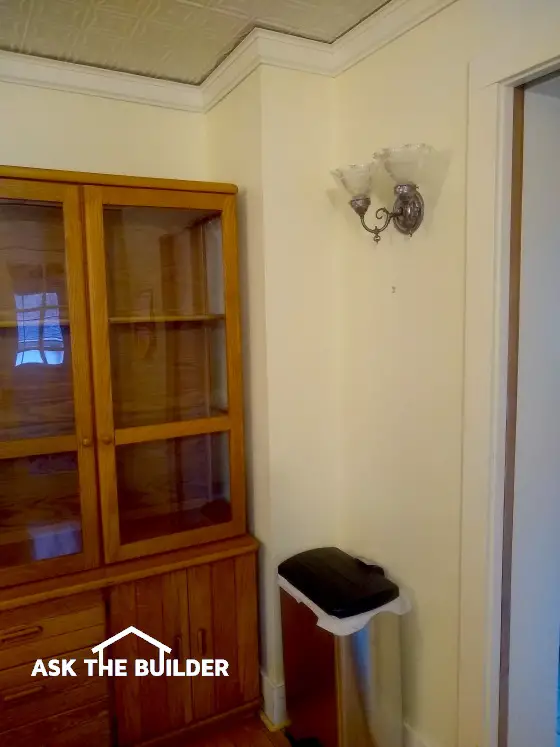Hide Plumbing Pipes

Hide Plumbing Pipes | This is a pipe chase. If you took off the plaster or drywall you’d see a 3 or 4-inch plumbing drain pipe and the hot and cold water lines going up to a second-floor bathroom. Copyright 2020 Tim Carter
Hide Plumbing Pipes in a Chase or Closet - HVAC Ducts Too!
QUESTION: Oh, Tim do I have a conundrum for you! A major remodel is about to happen here at my home and already we’ve got a problem. A new master bathroom is being created in a second-floor room but I can’t figure out how to get the drainpipe down to where it will connect to the rest of the plumbing drain pipes. How have you done this in the past on your jobs? But wait, there’s more! We need to get larger ductwork up to the second floor as well! Help me Tim Kenobi, you’re my only hope. Dawn J., Scranton, PA
You may have had similar challenges to Dawn’s. What’s interesting is these tough situations also present themselves in new homes too. I’ve been a master plumber since age 29 and each week I draw plumbing isometric and riser diagram plans for homeowners so they can get a plumbing permit. When I study their floor plans, I’m stunned to see many architects don’t think through how pipes need to get from one level to the next with as few bends as possible.
Should Architecture Students Do Co-op Work in Construction?
This is one reason I feel that architecture students should be required to have construction, not drawing, co-op jobs for half of the time they’re obtaining their degrees. I feel they need to work on actual job sites side-by-side with both carpenters, plumbers, and HVAC tradespeople. When these young fertile minds actually have to figure out how to make things work in the real world instead of on a computer monitor, their plans will be so much better in the future.
CLICK or TAP HERE for the BEST Quiet Plumbing Drain Pipes.
How can you hide plumbing pipes?
The architects of old often solved these issues with strategically placed walls, pantries, and closets on the level below where the bathroom would be. A wall on the lower level might be 6 inches thick for piping although 8 inches is far better.
CLICK or TAP HERE to get FREE BIDS from local carpenters that can build a pipe chase for you.
An architect might make one, or more, of the walls of a closet thick enough to accommodate the pipe or ducts. A false cavity can be created in the back of a closet by adding a second wall to the back of a closet. This cavity works well to get a large duct trunkline from one level to the next.
What is a corner pipe chase?
Corner pipe chases are also great ways to disguise pipes or ducts that have to go from one level to the next. To balance out the look in a room, you can always add a faux one in another corner. In the past, I’ve even built a long shelving unit that extends down from the ceiling about 16 inches that spans between the needed pipe chase and the faux one. All sorts of decorative items can be put up on the shelves and this takes your eye away from the pipe chases. The average person thinks the chases are needed to support the giant horizontal shelf.
It’s important for you to realize that you have some flexibility with the plumbing drain line. A typical residential bathroom with a toilet, shower, bathtub, and even two vanity sinks can be connected to one 3-inch pipe.
Can Plumbing Drainpipes Run Horizontally?
This pipe can run horizontally a significant distance, even up to 25 feet or more, before having to turn down to get to the next level. You can even have several 45-degree fittings in this horizontal run. Just be aware this pipe needs to slope 3/16ths inch for each foot of horizontal run so the liquids in the pipe don’t outrun the solids.
Knowing this, you may be able to extend the drainpipe to another room on the lower level away from the master bathroom above. The pipe chase might end up in the corner of some other room or even be inside a closet. It’s all a matter of how lucky you are with respect to the run of the floor joists below the new master bathroom.
CLICK or TAP HERE to get FREE BIDS from local carpenters that can build a pipe chase for you.
How Big Can Holes and Notches Be in Floor Joists?
Be aware there are very strict building code requirements and structural best practices when it comes to creating holes in floor joists for pipes. Notching floor joists is never to be done as it weakens them. Holes drilled through floor joists need to be certain sizes and in very specific locations. The building code addresses these and there are quite a few helpful online guides you can reference.
Should PVC and ABS Pipes Be Insulated?
If you’re using PVC or ABS plastic piping for the bathroom, be sure to install sound-deadening insulation around the pipes in both the ceiling and the vertical pipe chase once everything has been leak tested. The water flowing through and down the plastic pipes vibrates them with ease. This is why it sounds like a waterfall is in your walls if no insulation is present. You can eliminate this noise using no-hub cast iron drain pipes.
Your ductwork challenges are the same as for the plumbing drainpipe, only bigger. Ductwork is much larger than a plumbing stack and needs far more space. You may need to construct soffits in a room and disguise these creating a trayed ceiling in a room or two so the soffit doesn’t stick out like a sore thumb.
Column 1382